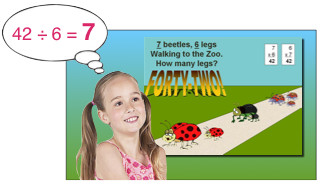Search Articles
Print or Share Flyer

One of the key predictors of Mathematical success is whether or not a child has mastered his/her basic Math facts! Math fluency is a crucial foundation in a child’s academic growth and is, therefore, included as part of the Common Core state standards. Factivation!® offers a simple system for mastering all basic Math facts, while also providing support materials that cover several CCSS OA and NBT standards for various grade levels.
[spacer]
Add and subtract within 20, demonstrating fluency for addition and subtraction within 10. Use strategies such as counting on; making ten (e.g., 8 + 6 = 8 + 2 + 4 = 10 + 4 = 14); decomposing a number leading to a ten (e.g., 13 – 4 = 13 – 3 – 1 = 10 – 1 = 9); using the relationship between addition and subtraction (e.g., knowing that 8 + 4 = 12, one knows 12 – 8 = 4); and creating equivalent but easier or known sums (e.g., adding 6 + 7 by creating the known equivalent 6 + 6 + 1 = 12 + 1 = 13).
*NOTE: In addition to providing simple strategies to aid with recall (Rule, Trick, Chant, Connection), Factivation!® goes a step beyond by also addressing other parts of this first grade CCSS standard. The relationship between Addition and Subtraction is addressed in many of the printables and the “Adderpillar” activity (in the Intro section of each Addition/Subtraction lesson) teaches students to create known equivalents like the example above.
[spacer]
*NOTE: In addition to providing fluency strategies (Rule, Trick, Chant, Connection), Factivation!® continually addresses the relationship between Multiplication and Division, in both its printable and video resources.
[spacer]
Multiply a whole number of up to four digits by a one-digit whole number, and multiply two two-digit numbers, using strategies based on place value and the properties of operations. Illustrate and explain the calculation by using equations, rectangular arrays, and/or area models.
[spacer]
Return to Homepage
[hr]
“A schema is composed of organized personal background knowledge, and it acts as a filing system that has been set up to organize past experiences and interpret future experiences…Think of this background information as a hook on which to hang new information or a file folder into which new information can be integrated.” *
* Quote from How to Teach Balanced Reading and Writing, Bonnie Burns, 2006.
[/span12] [span7]7X6=42 (above): Many students may know that beetles are insects and that insects have six legs. For students lacking that prior knowledge, background information is provided (see screenshots above) in the Lesson 6 videos. Another familiar schema used in the “7 Beetles” Chant is with patterns of sound. Rhythm and rhyme aid recall and allow students to remember this chant with little effort. Learning this simple rhyme provides the needed background knowledge into which the introduced facts, 7X6 and 6X7, are applied. Some students need only hear “7 beetles, 6 legs, walking to the zoo…” a few times to permanently store these factors (6 and 7) with the product of 42.

3X4=12 and 7X8=56 (above): The schema used here is counting. Consecutively saying “1,2,3,4” comes naturally to most students, as does “5,6,7,8.” Presenting the multiplication facts 3X4 and 7X8 using this existing schema assists the learner in applying meaning to these facts, allowing for easier recall. Aiding memory, also (for all facts in the chant group) is the use of rhythm.[spacer]

Meaningful facts are not only easier to recall, but much more fun to learn, resulting in students being excited about Multiplication and math, in general.

42÷6 =7: With the “7 Beetles” chant background knowledge now established, students confronting the division facts 42÷6 or 42÷7 can easily apply that new information to what is already known (that 6,7,and 42 belong together). Students gain a complete understanding of the reciprocity of Multiplication and Division when taught to apply the Factivation!® strategies to BOTH operations.
[spacer][spacer][spacer][spacer]
(from www.web-us.com/memory/human_memory.htm):
“Schemas are clusters of knowledge about an event or object abstracted from prior experience with the object (we tend to recall objects that fit our conception of the situation better than ones that do not).”
Schemas are bits of knowledge about a Multiplication/Division fact taken from prior experience with the fact. (Students tend to recall these facts better than others.) The Factivation!® videos provide this prior knowledge, so facts are quickly learned and retained.
[spacer]
Return to Homepage
[hr]
The video below is one of our fluency building “Fast Facts” videos. All Addition videos are themed. This one is our “dance party” theme.
The “Fast Facts” videos are intended for use after conceptual understanding of the focus facts has been established through the introductory activities and after students have watched the instructional video for the lesson, which presents simple strategies to aid in recall.
[spacer]
[vooplayer vooid=’MTUzMzA=’ width=’750′ height=’606′]

[span4]

The traditional times table has intimidated and overwhelmed many students. Factivation!® for Multiplication uses a much more effective approach by condensing the Multiplication facts into logical, manageable groups that are simple for students to learn.
[/span4] [span6]
(See above!) Factivation!® for Multiplication uses four brain-friendly strategies (RULE, TRICK, CHANT, and CONNECTION) to teach all of the Multiplication facts. The ongoing emphasis of the commutative property allows for fewer facts to be “taught”. Compare the colorful, condensed Factivation!® for Multiplication chart (above) to the Times Table (left).
[/span6]
[/row]
[spacer]
Return to Homepage